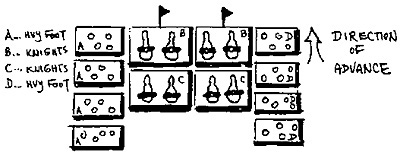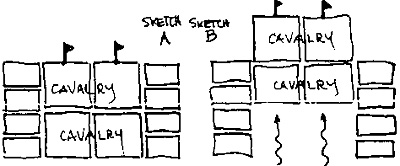Brian Dewitt and I ran through an ARMATI game, trying to assess the nitty-gritty of which the system was composed, i.e., the "recognizeable patternry" of the era in which our battle was fought.
I had played ARMATI several times before, but each time it was with someone guiding me through the procedures. Here, the intent was to see if Brian and Z could make our way unaided through the text. It turned out that for gaming purposes... in my mind, at least... we chose the two worst possible opposing forces in the army listings. I commanded a French 100 Years War army, and Brian led an English 100 Years War force.
I was given four units of knightly knights, Brian only two. But Brian's English army, in true historical fashion, contained an unholy number of longbow units, able to pop away at a 24 inch range. My own assigned French archers were crossbowmen; two dinky little units with an 18 inch range.
I've played other medieval rules systems, setting up 100 Years War battles, and the result has always been the same. The French come charging in, awhoopin' an' ahollerin', and the English longbowmen keep firing and firing, and the result is a lot of dead French knights and a decimated French army.
Granted, this was true for Agincourt and Crecy, but, gee whiz, fellers, this war lasted 100 cotton-pickin' years... surely the French must have won a battle or two during this time. Surely, there were a couple of battles in which the honor of France was redeemed. Surely, there was a battle in which the English longbowists left their arrows at home. The French must have done something right to last 100 cotton-pickin' years!!
Be that as it may, there I was with my gallant French knights (heavy cavalry), some mounted Men at Arms (heavy cavalry), and some Foot (heavy infantry). According to the ARMATI army listing, I was to divide this heavy contingent into three controlled groups or "divisions". I could have divided them into more groups, but 3 was deemed to be the maximum number of divisions my commander could manage, hence divisions in excess of 3 would not be permitted to move at all throughout the battle.
In retrospect, I think I did the dumbest thing possible... I assigned to two of my heavy divisions both infantry and cavalry, thus slowing down the mounted troops (12 inches per bound) to the speed of the infantry (6 inches per bound). Which meant that those bloodthirsty English archers had that much more time to fire at them as they tried to close.
In part, my division assignments were made because I misread the rules pertaining to "obligatory charges".
Certain units, said the book, must charge when they approach within smelling distance of the enemy; they will surge forward to contact without waiting to be told to so so.
And what's even better, said the book, was the fact that my heavy cavalry had "impetus". . . all I had to do was win the first round of melee, and my opposing unit was broken... it would flee the field, and off it would go, causing other enemy units to take a morale test.
 The sketch shows one of my heavy divisions. It consists of four units: 2 mounted knights, one behind the other, and 2 foot units, one on each flank.
The sketch shows one of my heavy divisions. It consists of four units: 2 mounted knights, one behind the other, and 2 foot units, one on each flank.
A cursory reading of the rules led me to believe that when the mounted knights came within charge distance of the English, they would break ranks, i.e., break out of the division, and charge into contact, leaving the slower moving footmen behind.
But cursory is not good enough... after all, this is war... and my attention was finally drawn to a key sentence which read a part of it is obligated to charge.
Which meant that the footmen held up the knights until the footmen themselves could make contact. Which meant that the longbowmen got in yet another valley...
This arrow-volley business was bad business for me. Normally, when one is fired at, one takes one's target unit's protective factor and adds it to a 6-sided die roll. The firing unit also gets a die, unmodified, and if his total is more than yours, a hit is scored. Against longbows, however, all units had their protective factor nulled, so that it was simply my die roll, unmodified, against Brian's.
Now while Z was doing my own bookly research, Brian was doing his, and he came up with the coup de grace for my French army.
What he came up with was a section on "stakes". By not moving or firing for one turn, his longbowmen were permitted to plant stakes.
These devilish devices did two things to my knightly knights:
First, they took away their "impetus"... which meant that the knights couldn't break a unit on the first round of melee, and Second, they took away the knights' combat factor of "+6", and reduced it to "2". Combat factors are added to a 6-sided die roll, and the totals compared to produce the winner of a round of melee. You'll note that a modifier of "6" is a super modifier, especially when added to a 6-sided die roll.
And so, shorn of their impetus, deprived of their "+6", my French knights lost heart. Instead of charging mightily into the English lines, they merely bumped into them, and essentially made no impact at all.
I commenced the battle with a total of 11 heavy units, infantry and cavalry. By definition, I would lose the battle when 5 of these were destroyed.
Easily done, said Brian, and his archers went wump! wump! wump!... at battle's end, I lost my 5 units, and Brian had lost only one.
 The sketch shows one of my heavy divisions. It consists of four units: 2 One question which we researched, and couldn't resolve, concerned the relative positioning of units within a division. My heavy division, shown in Sketch A below, had 2 units of foot attached, one on either flank.
The sketch shows one of my heavy divisions. It consists of four units: 2 One question which we researched, and couldn't resolve, concerned the relative positioning of units within a division. My heavy division, shown in Sketch A below, had 2 units of foot attached, one on either flank.
Once the division starts to move, can the relative positions of the infantry and cavalry change? As shown in Sketch B, car. the center cavalry units "slide forward", still touching the infantry, and maintain division integrity? Or must the initial division formation be rigidly observed?
In our perusal of the rules book, we found that the ARMATI text covered just about everything in which we were interested. Some issues, of course, are buried, while others spring out at you. In the main, however, 'twas an interesting experiment.
Another question that popped up concerned targeting a division composed of several units. If one of the units in the division is in melee, are any of the other units viable targets? The text states only that a unit in combat cannot be fired on; it's silent on this other issue.
But our in-house experts quickly disposed of this question... any unit in the division not in contact, and not in melee, is a valid target.
Digression.
Back to the Hundred Years War, for a moment... I did some exhaustive research on the era (3 minutes or so) and found out that the period of interest starts around 1337 and ends around 1457. The period started with a bang for the English in 1346 at Crecy, and there are a couple of battles stretching over the next 78 years which are always cited to show the predominance of the English bowmen. These are Crecy (1346), Poitiers (1356), Agincourt (1415), and Verneul (1424).
What happened in-between-times is anybody's guess... but I would imagine that the French must have won once or twice, perhaps even thrice. After Verneul, which the history book stated was the "English archers' last strategic victory", the French were all over the English.
Perhaps we should rename the period the "78 Year War" to give the French the benefit of the remainder of the era during which the English bowmen were phased out. End of digression.
Saxons and Vikings
The next weekend, Brian brought over his 15mm Saxons and Vikings. I forgot to mention that the previous French/English battle took place with his 25mm figures.
Under the tutillage of John Shirey and Jeff Wiltrout, we ran through 2 quick battles. In the first, John and I set out our Saxons, and according to the ARMATI text, we diced to see what terrain pieces would appear.
FOOSH!... and we were gifted with three hills... good defensive terrain, said John. Brian declined to toss for any terrain pieces. And so our Saxons sat on the hills and watched the Vikinqs approach. It turns out that the Viking army had several bowcarrying units, Bondi, who, like the English archers of our former encounter, reached out and did grievous harm to our waiting Saxons. When we finally smartened up and came charging off our hills, 'twas too late... most of our units had been weakened by bow fire, and we quickly collapsed.
In Battle #2, our Saxons, instead of waiting, advanced to meet the Vikings. I am proud to say that Saxon honor was redeemed.
Back to PW Review Nov/Dec 1994 Table of Contents
Back to PW Review List of Issues
Back to MagWeb Master Magazine List
© Copyright 1994 Wally Simon
This article appears in MagWeb (Magazine Web) on the Internet World Wide Web.
Other military history articles and gaming articles are available at http://www.magweb.com